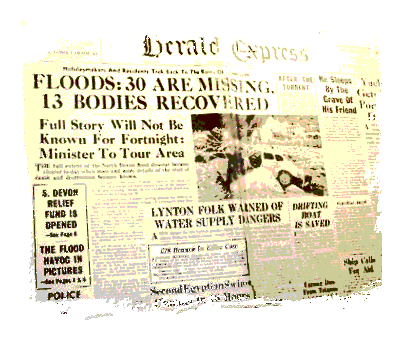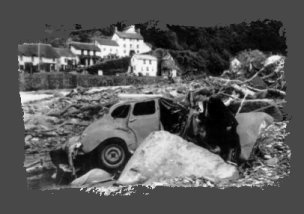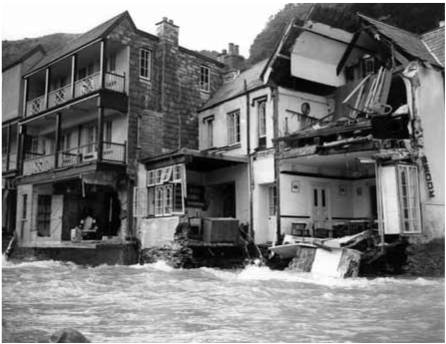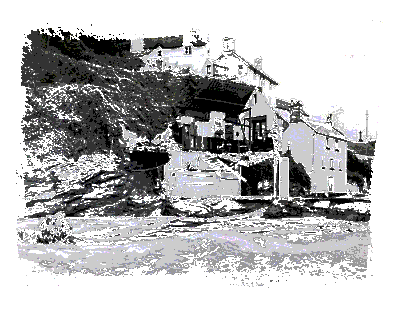It looks like you're using an Ad Blocker.
Please white-list or disable AboveTopSecret.com in your ad-blocking tool.
Thank you.
Some features of ATS will be disabled while you continue to use an ad-blocker.
share:

The weather in these rain soaked isles is frequently a topic of conversation in the UK. But it is rarely mixed in with a tale of government conspiracy, the death of innocent citizens and the devastation of a whole community in South West England. Here is an incident mixing all of those very elements together.
On August 15th 1952 the village of Lynmouth, North Devon, England experienced torrential rainfall (250 times the normal level of rain fell across the month). More than 60 years later it is still rumoured that the British Government tried to manipulate the weather causing unforeseen death and destruction. The Lynmouth disaster was officially termed "the hand of God”. Somewhat ironically survivors described how the air smelled of sulphur. It was as if the Devil himself had cast his evil presence there on the day of the floods.
 The rains had been coming down since early morning beating down heavily through
the afternoon. The storm worsened early in the evening, followed by a darkening of a sky scattered with yellow, green and purple hues. The deluge
raged for hours as the East and West Lyn Rivers engulfed the village. Ninety million tonnes of water violently washed into Lynmouth down a narrow
valley. Trees were uprooted and, along with huge boulders carried by the water, smashed into and destroyed whole buildings. Over 400 people were left
homeless and, saddest of all, 35 people lost their lives. Many were washed out to sea and never found.
The rains had been coming down since early morning beating down heavily through
the afternoon. The storm worsened early in the evening, followed by a darkening of a sky scattered with yellow, green and purple hues. The deluge
raged for hours as the East and West Lyn Rivers engulfed the village. Ninety million tonnes of water violently washed into Lynmouth down a narrow
valley. Trees were uprooted and, along with huge boulders carried by the water, smashed into and destroyed whole buildings. Over 400 people were left
homeless and, saddest of all, 35 people lost their lives. Many were washed out to sea and never found. 
Dilys Singleton lost six members of her family including her grandmother. Dilys’ mother had to identify her by a wart on her back after her remains were found with no head or limbs.
The owner of the Lyndale Hotel, Tom Denham, was not too concerned initially when his cellars flooded as it had happened before. But hours into the storm at 9.30pm he reported:
“There was a tremendous roar. The West Lyn had broken its banks and pushed against the side of the hotel, bringing with it thousands of tons of rocks and debris in its course.
"It carried away the chapel opposite and a fruit shop. Three people in the fruit shop were swept against the lounge windows of the hotel. We managed to pull them through in the nick of time.
"I then ordered everyone to go to the second floor, where they huddled in the corridors for safety. In all we had 60 people in the hotel all night."
Derek Harper, a young 21 year old rookie policeman, started duty as the storm began to break – he was later awarded the George Medal for his bravery. At first he heard reports of rubble gathering on Lynmouth Hill but knew nothing of the disaster to come.
 As reports reached crisis level he ventured out with six local firemen towards a
nearby farm. They had to turn back as tonnes of mud, water and rubble, blocked the route. They managed to save a shopkeeper who had been trapped in
her basement as the floodwaters began to rise. On reaching Barbrook Bridge they found it flooded with water and so Harper straddled the bridge,
secured with a rope that the firemen gripped at the other end. Derek felt a shudder as the bridge collapsed and luckily the firemen held on and
dragged him to safety. Around 100 properties, over 130 vehicles, 19 boats, 28 bridges and countless domestic, farm and wild animals were washed away
including the Rhenish Tower (pictured left), a prominent local landmark.
As reports reached crisis level he ventured out with six local firemen towards a
nearby farm. They had to turn back as tonnes of mud, water and rubble, blocked the route. They managed to save a shopkeeper who had been trapped in
her basement as the floodwaters began to rise. On reaching Barbrook Bridge they found it flooded with water and so Harper straddled the bridge,
secured with a rope that the firemen gripped at the other end. Derek felt a shudder as the bridge collapsed and luckily the firemen held on and
dragged him to safety. Around 100 properties, over 130 vehicles, 19 boats, 28 bridges and countless domestic, farm and wild animals were washed away
including the Rhenish Tower (pictured left), a prominent local landmark. With telephone lines down Harper eventually scrambled his way out of town to sound the alarm and an evacuation began.

As clean up operations were put into action, survivors wanted to know why RAF aircraft had been circling in the skies over Devon prior to the storms. The Ministry of Defence denied carrying out “cloud-seeding” experiments in August 1952 although many local people suspected a cover up.
Their Member of Parliament ,Tony Spellar, even tried to investigate the issue in the 1980s and to his frustration was informed that the files had been missing for years.
It was not until the 21st century when a different approach was taken that researchers found documents relating to an “Operation Cumulus” and showing that weather manipulation trials were ongoing from 1949 to 1955 across the UK. The MoD’s Meteorological research flight at Farnborough, scientists at Cranfield School of aeronautics and ICI were all involved. RAF logbooks, statements from personnel involved and met office data was used to piece together the events leading up to the Lynmouth disaster. An old radio interview from 1952 was also tracked down from an engineer and pilot, Alan Yates, confirming his part in Operation Cumulus and how he had spread salt over the skies of Bedfordshire leading to a heavy downpour in Staines, Middlesex some 50 miles away.

"I was told that the rain had been the heaviest for several years - and all out of a sky which looked summery ... there was no disguising the fact that the seedsman had said he'd make it rain, and he did. Toasts were drunk to meteorology and it was not until the BBC news bulletin [about Lynmouth] was read later on, that a stony silence fell on the company,"
Source: www.guardian.co.uk...
Archive footage of the Lynmouth disaster
Declassified minutes from an air ministry meeting, held on November 3, 1953, show that the military were interested in increasing rain and snow by artificial means to aid "bogging down enemy movement", "incrementing the water flow in rivers and streams to hinder or stop enemy crossings", and clearing fog from airfields. The documents also discuss that rainmaking had the potential "to explode an atomic weapon in a seeded storm system or cloud. This would produce a far wider area of radioactive contamination than in a normal atomic explosion".
There is no conclusive proof that the MoD conducted any experiments that led to the Lynmouth disaster in 1952. Meteorologists point to the storm engulfing the whole of the West Country and South Wales and that all previous experiments were of a limited yield. There is also evidence that a similar devastating flood hit the area in 1770 long before man could fly, let alone play with nature.
However 50 years after the Lynmouth disaster the whole planet has been experiencing some freak weather over the past decade. Technology has moved on exponentially since the 1950s.
Is it all down to Mother Nature?
Or are secret military projects still being implemented on our environment?
More to the point, would you expect any government to admit to it if there were?
History Channel clip
Sources:
Nat Archives Ref: AIR2/13343 Rainfall of August 15th 1952
www.whatdotheyknow.com...
news.bbc.co.uk...
www.dailymail.co.uk...
news.bbc.co.uk...
www.weatheronline.co.uk...
edit on 25/5/13 by mirageman because: Everybody looks to the left, everybody looks to the
right
What may of happened was the MoD are playing with seeing if they can guarantee a rainstorm but at that time not knowing what they was messing with as
the weather forecasts would of been crap compared to now and with the slow interchange of data it could of been that a rather nasty storm what would
of caused some trouble was excited another level and caused such a bad problem
reply to post by Maxatoria
That's plausible. There is documentation to prove that these experiments were going on and that there was a temporary suspension after the disaster. The cloud seeding prior to the floods may well have aggravated storm conditions rather than being the sole cause of the violent weather. Unfortunately any official MoD documents have been declared 'missing' and we shall never know the truth.
That's plausible. There is documentation to prove that these experiments were going on and that there was a temporary suspension after the disaster. The cloud seeding prior to the floods may well have aggravated storm conditions rather than being the sole cause of the violent weather. Unfortunately any official MoD documents have been declared 'missing' and we shall never know the truth.
I've personally have never bought into that whole HARP business, but that was intriguing maybe I'll keep an open mind from now on.
S&F that was the best thread in weeks maybe months.
S&F that was the best thread in weeks maybe months.
reply to post by mirageman
Cockermouth Floods Cumbria England and other incidents?
17th November 2009 - if it happenned once?
Cockermouth Floods Cumbria England and other incidents?
17th November 2009 - if it happenned once?
edit on 25-5-2013 by deprogrammer because: (no reason given)
reply to post by mirageman
Terrific presentation. Cloud seeding in the hands of the military for defensive purposes only? There's no doubt in my mind that they surely have come a long way since the beginning, but what I'm wondering is whether they can affect the weather in other countries now
Terrific presentation. Cloud seeding in the hands of the military for defensive purposes only? There's no doubt in my mind that they surely have come a long way since the beginning, but what I'm wondering is whether they can affect the weather in other countries now
From your Philip Eden link:
A few gliders were not going to ever make 90 million tons of water fall from the sky over an area of hundreds of square miles.
The storm which caused the 1952 disaster was not confined to the Lynmouth district. Heavy rain fell over the whole of the West Country and south Wales, and it was caused by a depression which had stagnated in the Southwest Approaches for two days. Similar depressions have triggered serious flooding in southwest England at regular intervals, and previous devastating floods hit Lynmouth in the 18th and 19th centuries. The August 1952 depression was several hundred miles across, and the prolonged heavy rain associated with it was caused by the large-scale lifting of very moist air. A fleet of RAF Hercules stuffed with dry ice wouldn't have made a ha'p'orth of the difference.
A few gliders were not going to ever make 90 million tons of water fall from the sky over an area of hundreds of square miles.
Originally posted by mirageman
There is no conclusive proof that the MoD conducted any experiments that led to the Lynmouth disaster in 1952.
Meteorologists point to the storm engulfing the whole of the West Country and South Wales and that all previous experiments were of a limited yield.
There is also evidence that a similar devastating flood hit the area in 1770 long before man could fly, let alone play with nature.
Thank you for debunking the myth that Lynmouth was destroyed by a government experiment.
Ha ha ha. That someone would link this to a conspiracy is hilarious for us, and reveals insanity in them.
reply to post by mirageman
This is all very interesting.
Thank you for informing me about this.
Cool thread and I like how you formatted the graphics I need to learn how to do stuff like that.
It makes things look very professionally put together how you can wrap around the photos.
This is all very interesting.
Thank you for informing me about this.
Cool thread and I like how you formatted the graphics I need to learn how to do stuff like that.
It makes things look very professionally put together how you can wrap around the photos.
reply to post by mirageman
I've been away for ten or so weeks, what a fantastic op you have for us. Can't wait to read the replies especially from the usual thread killers.
S&F
I've been away for ten or so weeks, what a fantastic op you have for us. Can't wait to read the replies especially from the usual thread killers.
S&F
Very good read and I thank you for presenting this excellent thread for all to enjoy and think about.
You put a lot of work into your post.
These are the type of threads that really make ATS a great site.
Regards, Iwinder
You put a lot of work into your post.
These are the type of threads that really make ATS a great site.
Regards, Iwinder
More to the point, if a government had the ability to do this - would you believe they wouldn't?
line deux
line deux
reply to post by Aloysius the Gaul
A few gliders were not going to ever make 90 million tons of water fall from the sky over an area of hundreds of square miles.
I'm not so sure that link has had access to the RAF logbooks in question, after all how many Hercules did the RAF have in 1952?
reply to post by mirageman
I for one believe it as it would be far from the first or last time British citizens, civilian as well as military, were used as guinea pig's by there own government, few outside the UK know it but both the size well B and the Windscale (now sellafield) nuclear incidents made 4 mile island in the states look minor but the people were not evacuated and the radioactive material was merely flushed out to sea, In Scotland was a disused mine the ran under the sea bed so with all the waste from the nuclear and chemical trials were do you think the put it, yes down the mine and sometime about 6 years after they sealed the mine there was an underwater explosion that was probably caused by leaking chemical's and nuclear material interacting down the mine as for many years and even too today there are radio active particles washing ashore, that is one reason Europe used to call us the dirty old man or Europe and not because of the many coal fire placed in home's though that undoubtedly played it's part.
I for one believe it as it would be far from the first or last time British citizens, civilian as well as military, were used as guinea pig's by there own government, few outside the UK know it but both the size well B and the Windscale (now sellafield) nuclear incidents made 4 mile island in the states look minor but the people were not evacuated and the radioactive material was merely flushed out to sea, In Scotland was a disused mine the ran under the sea bed so with all the waste from the nuclear and chemical trials were do you think the put it, yes down the mine and sometime about 6 years after they sealed the mine there was an underwater explosion that was probably caused by leaking chemical's and nuclear material interacting down the mine as for many years and even too today there are radio active particles washing ashore, that is one reason Europe used to call us the dirty old man or Europe and not because of the many coal fire placed in home's though that undoubtedly played it's part.
Originally posted by Morg234
reply to post by Aloysius the Gaul
A few gliders were not going to ever make 90 million tons of water fall from the sky over an area of hundreds of square miles.
I'm not so sure that link has had access to the RAF logbooks in question, after all how many Hercules did the RAF have in 1952?
None of course - they would have had to use Hastings, Varsitys and Valettas - which would have carried even less per aircraft and required even more flights!
reply to post by Morg234
None. In fact, the original C-130A didn't fly until 1954 I think? The RAF didn't receive their first aircraft until a fair while after...
None. In fact, the original C-130A didn't fly until 1954 I think? The RAF didn't receive their first aircraft until a fair while after...
reply to post by infiltraitor
Correct. The C-130 joined the RAF in 1966. The Gaul lists the types of transport aircraft the RAF were operating in 1952
Correct. The C-130 joined the RAF in 1966. The Gaul lists the types of transport aircraft the RAF were operating in 1952
reply to post by LABTECH767
I entirely agree, if anyone has any doubts as to what the government is capable of please do read this article which gives details of a previously unseen government report released in 2002 which shockingly detailed Britain's biological warfare trials which took place between 1940 and 1979.
The reports details events such as zinc cadmium sulphide being sprayed over large swathes of the population, a navy ship off the Dorset coast spraying e-coli and other bacteria over the coastline, and more bacteria being released in the London Underground. Of course the government insisted there was no risk to public health but then they would say that wouldn't they.
"Millions were in germ war tests
Much of Britain was exposed to bacteria sprayed in secret trials"
www.guardian.co.uk...
I entirely agree, if anyone has any doubts as to what the government is capable of please do read this article which gives details of a previously unseen government report released in 2002 which shockingly detailed Britain's biological warfare trials which took place between 1940 and 1979.
The reports details events such as zinc cadmium sulphide being sprayed over large swathes of the population, a navy ship off the Dorset coast spraying e-coli and other bacteria over the coastline, and more bacteria being released in the London Underground. Of course the government insisted there was no risk to public health but then they would say that wouldn't they.
"Millions were in germ war tests
Much of Britain was exposed to bacteria sprayed in secret trials"
www.guardian.co.uk...
new topics
-
More Bad News for Labour and Rachel Reeves Stole Christmas from Working Families
Regional Politics: 1 hours ago -
Light from Space Might Be Travelling Instantaneously
Space Exploration: 2 hours ago -
The MSM has the United Healthcare assassin all wrong.
General Conspiracies: 3 hours ago -
2025 Bingo Card
The Gray Area: 3 hours ago -
The Mystery Drones and Government Lies
Political Conspiracies: 5 hours ago
top topics
-
Pelosi injured in Luxembourg
Other Current Events: 12 hours ago, 16 flags -
The Mystery Drones and Government Lies
Political Conspiracies: 5 hours ago, 9 flags -
Nov 2024 - Former President Barack Hussein Obama Has Lost His Aura.
US Political Madness: 14 hours ago, 7 flags -
2025 Bingo Card
The Gray Area: 3 hours ago, 5 flags -
The MSM has the United Healthcare assassin all wrong.
General Conspiracies: 3 hours ago, 5 flags -
Light from Space Might Be Travelling Instantaneously
Space Exploration: 2 hours ago, 2 flags -
More Bad News for Labour and Rachel Reeves Stole Christmas from Working Families
Regional Politics: 1 hours ago, 2 flags
active topics
-
Pelosi injured in Luxembourg
Other Current Events • 23 • : bluesman023 -
Statements of Intent from Incoming Trump Administration Members - 2025 to 2029.
2024 Elections • 43 • : WeMustCare -
The MSM has the United Healthcare assassin all wrong.
General Conspiracies • 5 • : nugget1 -
2025 Bingo Card
The Gray Area • 8 • : gortex -
More Bad News for Labour and Rachel Reeves Stole Christmas from Working Families
Regional Politics • 1 • : nugget1 -
The Mystery Drones and Government Lies
Political Conspiracies • 24 • : xuenchen -
I See a Different Attitude This Time Around with Congress
US Political Madness • 29 • : interupt42 -
-@TH3WH17ERABB17- -Q- ---TIME TO SHOW THE WORLD--- -Part- --44--
Dissecting Disinformation • 3676 • : duncanagain -
Light from Space Might Be Travelling Instantaneously
Space Exploration • 13 • : cooperton -
A Bunch of Maybe Drones Just Flew Across Hillsborough County
Aircraft Projects • 82 • : xuenchen
